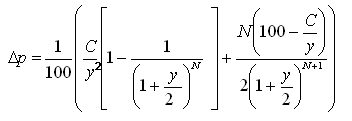A method of measuring the price sensitivity of a fixed-income security in monetary terms. This reflects absolute change in the value of a bond due to a 1 basis point change in interest rates or required yield. Typically, as this price (known for short as PVBP) increases, the dollar price volatility, also, increases. This means a bigger price value of a basis point means a bigger move in the bond’s price due to a given change in interest rates. The PVBP can be calculated by first finding out the price change using the following formula:

where:
C is the dollar value of coupon payments in one year
N is the number of coupon payments not yet made
Y is BEY or bond equivalent yield (decimal)
100 means the calculation relates to par value
For instance, assume a 20-year bond with 10% coupon rate and yield of 8%: that is, C = 10, N= 40, Y= 0.9. We can calculate the change in price due to 1% change in yield by plugging the above figures in the formula. It turns out that Δp = USD 12.35.
PVBP = Δp/ 100 = 12.35/100= 12.35 cents. Therefore, a 1 basis point increase (decrease) in interest rates will lead to a USD 12.35 decrease (increase) in the bond price.
The price value of a basis point is also known as the dollar value of a basis point (DV01).





Comments